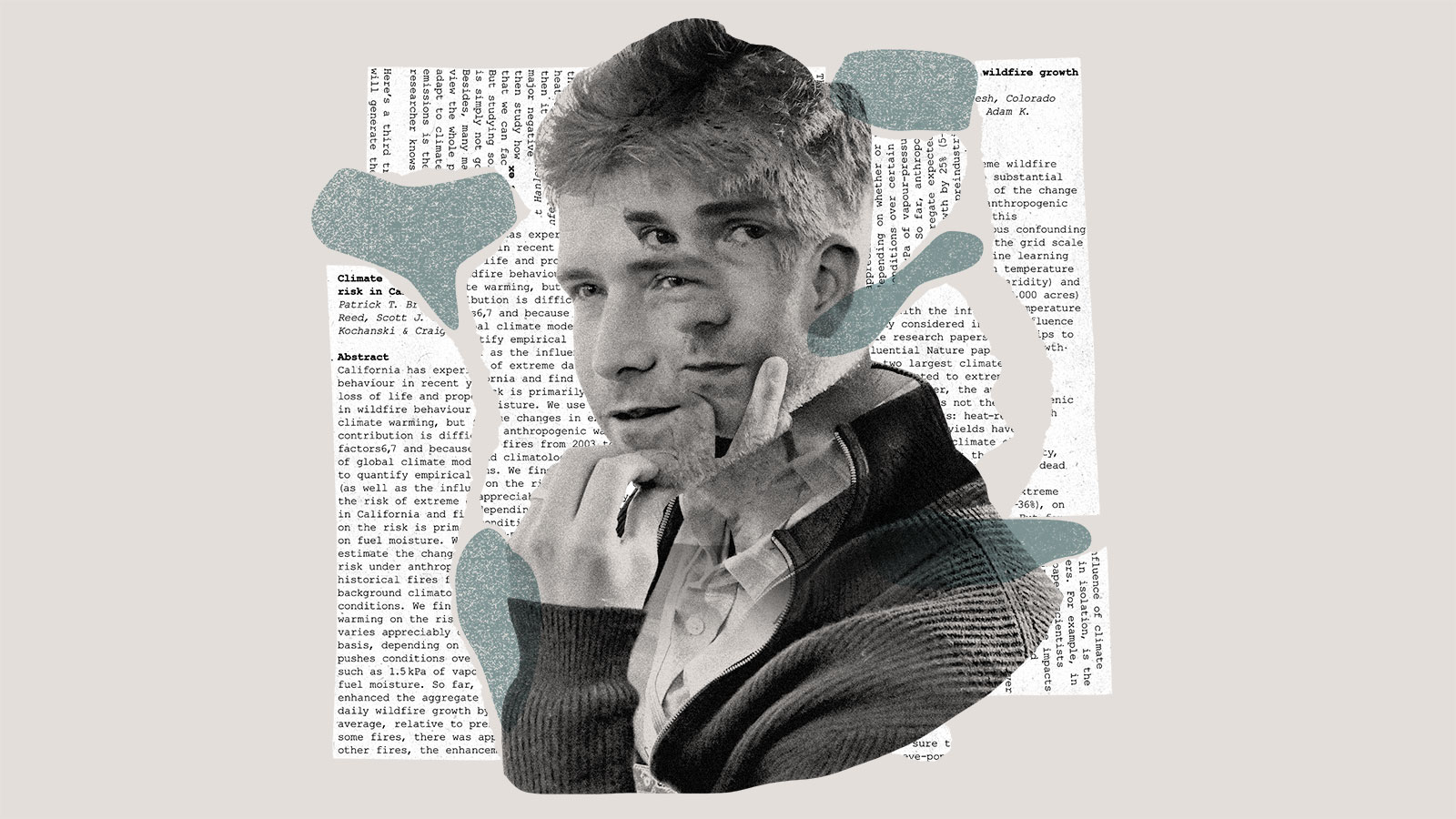This story is part of the Grist arts and culture series Moral Hazards, a weeklong exploration of the complex — sometimes contradictory — factors that drive our ethical decision-making in the age of global warming.
When a climate scientist’s inbox is flooded with requests to appear on Fox News, it’s a fairly clear sign they’ve done something controversial. For Patrick Brown, the moment arrived a year ago, mere hours after his essay titled “I Left Out the Full Truth to Get My Climate Change Paper Published” landed on the internet.
“I’m reaching out to invite you to our show tomorrow to discuss how the media’s obsession with global warming manipulates the truth about wildfires,” a booking producer for the morning show Fox & Friends First wrote to Brown on September 5, 2023, proposing a five-minute video interview at 5:20 a.m. the next day.
Brown was torn. Here was a chance, his wife urged him, to reach a new, national audience with his message: that “climate change is real and is important, but it’s not everything.” (It was an audience that would be, for a change, skeptical about the first half of that statement instead of the second.) Yet Brown was overwhelmed by the attention his piece was drawing and worried he wouldn’t be able to redirect the conversation away from anti-science talking points in such a short interview. “I felt like I would become too bullied into making this argument that climate change is all a hoax,” he said.
The drama had been set in motion one week earlier, when Nature, arguably the most prestigious scientific journal in the world, published a study Brown co-authored showing that climate change had increased the risk of explosive wildfires in California by 25 percent. When the paper came out at the end of August, colleagues congratulated him, and the research was covered by NPR, The Los Angeles Times, and other media outlets. “You’re treated like this just very, very important person, with super interesting things to say,” Brown said. “‘Thank you so much, Dr. Brown’ — you know, that type of thing.”
Then, a week later, Brown shocked many of his colleagues by criticizing his own study in his essay in The Free Press, an outlet that seeks to cover news stories “that are ignored or misconstrued in the service of an ideological narrative.”
Brown wrote that he had tailored the wildfire study to fit what high-impact journals seemed to want, with a single-minded focus on communicating the disastrous consequences of climate change. “The editors of these journals have made it abundantly clear, both by what they publish and what they reject, that they want climate papers that support certain preapproved narratives,” he wrote. This instinct, he said, came at the expense of more complex, solutions-oriented studies about, say, managing forests to reduce the risk of extreme fires.
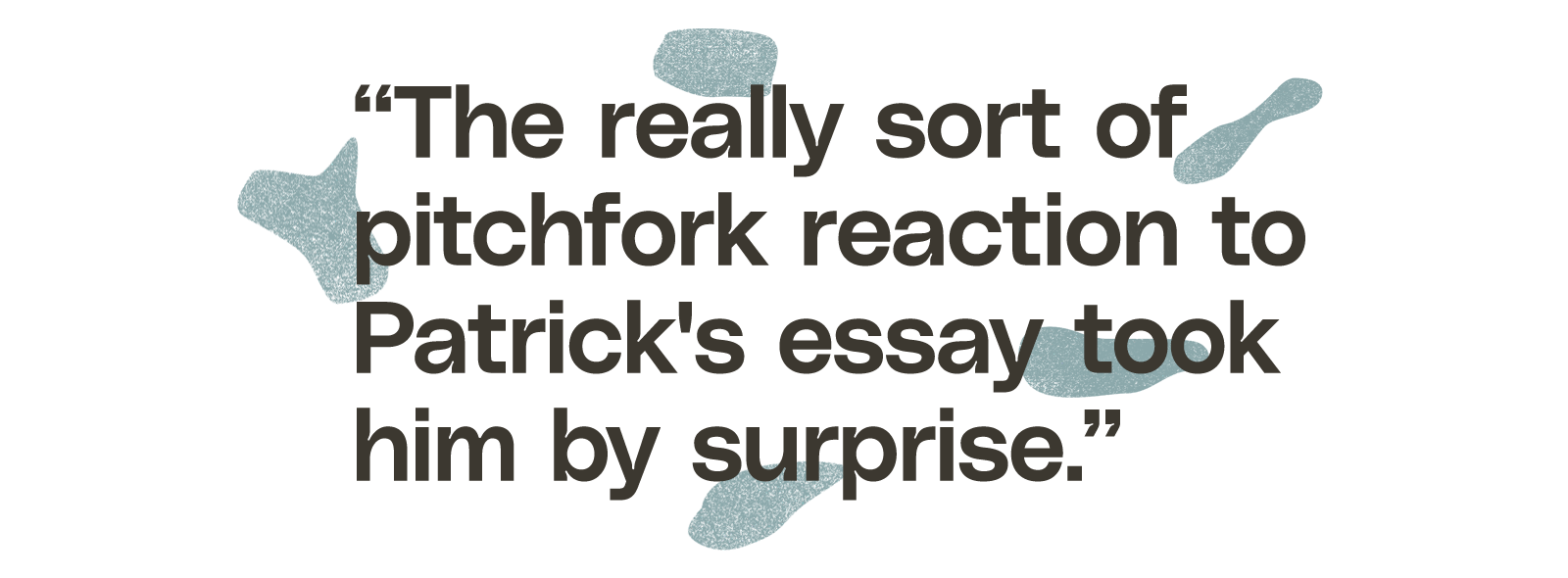
He stood by his study’s finding that global warming contributes to wildfires — “Make no mistake: That influence is very real,” he wrote — but argued that its narrow focus was part of a broader problem. “To put it bluntly,” he wrote, “climate science has become less about understanding the complexities of the world and more about serving as a kind of Cassandra, urgently warning the public about the dangers of climate change. However understandable this instinct may be, it distorts a great deal of climate science research, misinforms the public, and most importantly, makes practical solutions more difficult to achieve.”
Brown declined the Fox News interviews, but that didn’t stop many right-wing news outlets from seizing on the idea that scientists were somehow messing with climate data. “Climate change expert overhyped his findings,” read one headline, on the front page of the U.K.’s Daily Telegraph. Meanwhile, left-of-center news sources quickly passed the mic to Brown’s detractors. “Fact check: Scientists pour cold water on claims of ‘journal bias’ by author of wildfires study,” read the headline on the website Carbon Brief.
For several days, anyone who followed the conversation about climate change on X, formerly Twitter, couldn’t open the app without coming across attacks on Brown.
“The really sort of pitchfork reaction to Patrick’s essay took him by surprise,” said Alex Trembath, the deputy director of the think tank The Breakthrough Institute, where Brown co-directs the climate and energy team.

Although science clearly demonstrates that climate change is real and worsening, there’s still a muddiness around exactly how much it drives the floods, fires, and other impacts seen around the world today, compared to other factors. Covering cities in impermeable pavement, or stifling fires and letting forests overgrow, plays a role in how bad these disasters become. In blog posts, talks, and on social media, Brown examines these murky details, calling out oversimplification when he sees it, even if doing so might distract from what many colleagues see as the central task of stabilizing the Earth’s climate.
Brown’s choice — to embrace the gray over the green, so to speak — doesn’t make him popular with those who see a moral imperative to ditch fossil fuels as fast as possible. From their perspective, you could make the case that Brown is a disgruntled academic who’s undermining the public will to reduce emissions by alleging there’s bias in climate science and challenging the focus on catastrophe. From another, you could argue that he’s on a mission to make science more honest, informing the public about how humans might adapt to a hotter planet.
So is Brown a villain, a hero, or something more complicated?
The villain
The way a person characterizes the commotion that followed Brown’s essay starts with what to call it. The climate scientist Zeke Hausfather, for example, suggested it could be called “a series of unfortunate events,” a nod to the children’s books by Lemony Snicket. Sitting next to Brown at dinner during a Breakthrough Institute conference in June, I fumbled for words to ask a question about “the Nature incident.”
“We call it ‘the hullabaloo,’” Brown replied with a half-cocked smile.
At some point, in my head, I dubbed it “the Brown affair,” a reference to an episode from 1996, in which the physicist Alan Sokal submitted “an article liberally salted with nonsense” to a cultural studies journal. Sokal’s paper suggested that physical reality was “a social and linguistic construct” and put forth a bizarre theory about quantum gravity, claiming that it provided “powerful intellectual support for the progressive political project.” Sokal bet correctly that the journal would publish his word salad if “a) it sounded good and b) it flattered the editors’ ideological preconceptions.”
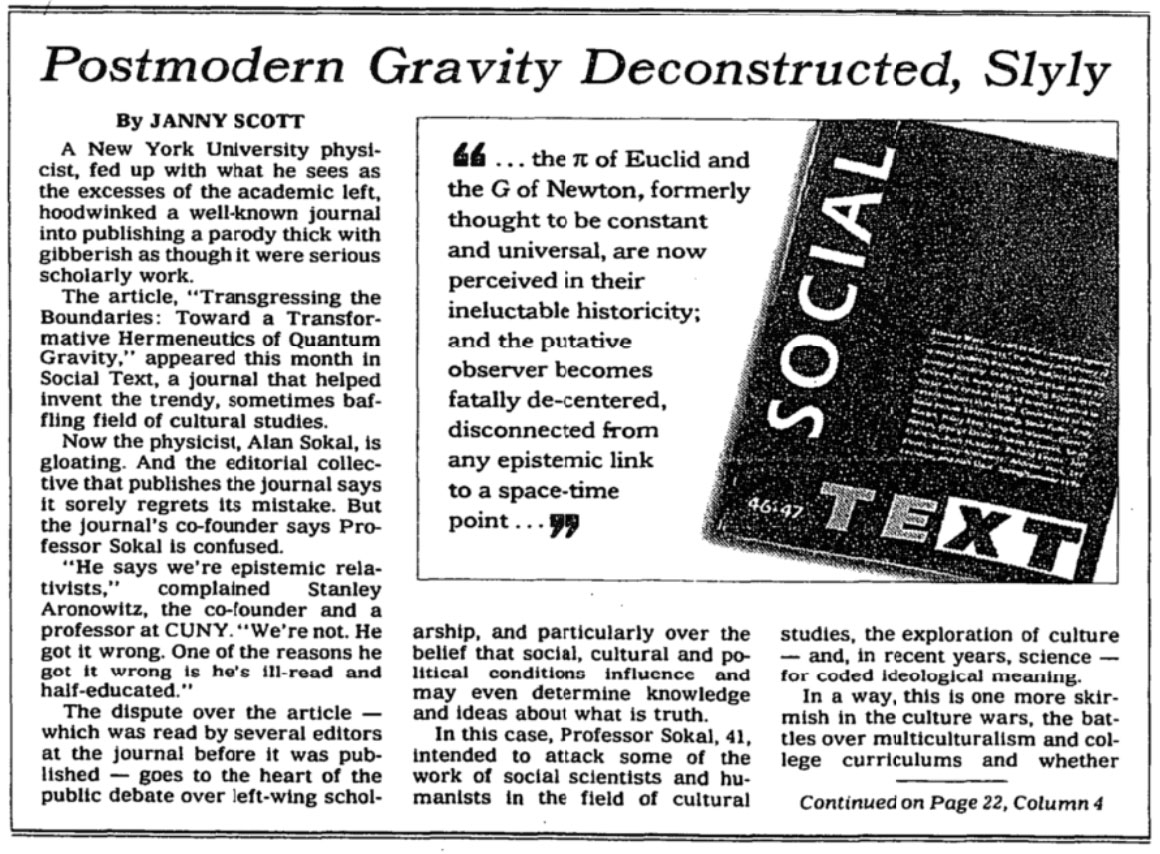
Sokal revealed the hoax in an essay in the magazine Lingua Franca a few weeks after the article was published, explaining that his intention was to highlight “sloppy thinking” among the academic left, who he thought were drifting away from objective reality. Sokal’s hoax made the front page of The New York Times and traveled as far as Le Monde in France, and decades later, the ethics of his experiment are still being debated. “In retrospect, I now see that I underestimated the interest of the general public in intellectual questions,” Sokal reflected in the 2008 book Beyond the Hoax.
This is the version of Brown, the villain: a Sokal 2.0, a prankster with suspicious ethics who’s providing fuel for oil companies, the far right, and the rest of the climate disinformation machine.
It’s a comparison made by Max Boykoff, a professor of environmental studies at the University of Colorado Boulder, who teaches the Sokal affair in his classes. Brown “deliberately appeared to have used some of the systems that we use in good faith — of peer review, of publishing — and manipulated that system,” Boykoff said.
One of Brown’s coauthors said he was blindsided by the about-face. “Patrick’s critique of our paper came as a surprise to me, and I don’t share his cynicism regarding Nature’s editorial bias,” Steven J. Davis, a professor of Earth system science at Stanford University, wrote in an email.
Unlike Sokal, Brown says he didn’t make a premeditated decision to try to undermine a journal’s credibility. He decided to write the essay in June last year, a month after Nature had already provisionally accepted the paper he’d been working on for years.
Still, Magdalena Skipper, Nature’s editor-in-chief, said in a statement that Brown’s essay revealed that his study published the week before reflected “poor research practices and are not in line with the standards we set for our journal.” To counter the argument that journal editors preferred alarming studies about climate change, Skipper pointed to recent papers that found marine heat waves don’t generally hurt bottom-dwelling fish, and that found the top factor in the decline of the Amazon’s carbon sink wasn’t climate change, but less law enforcement.
Skipper said studies that countered the consensus were actually “of special interest to us.” She also suggested that the peer reviewers of Brown’s paper had told him to account for the other variables he said were important, such as vegetation and fire management. (Brown wrote a long FAQ-style piece arguing that his critics took the peer review comments out of context, misrepresenting what the reviewers meant.)
Some commentators made the case that Brown had made much ado for little reason. In an extensive interview for the climate news site Heatmap, the journalist Robinson Meyer badgered Brown about whether he actually molded his paper to focus on climate change because of Nature’s “preferred narrative,” or because it was simply the easiest approach to a knotty research problem.
“Brown seems to have talked himself into the view that he did something wrong, but it’s not clear to me that he actually did,” Meyer wrote.
Brown is no climate denier, yet his critique of Nature mirrored the most common type of climate misinformation — attacks on scientists and the processes of science, said John Cook, a researcher at the Melbourne Centre for Behaviour Change in Australia. As a result, right-leaning sites easily used Brown’s essay to feed a narrative that climate research was being “censored” to fit the demands of “woke editors.” Fox News picked quotes from Brown’s piece and combined them with Republican talking points that Democrats are overplaying the role of climate change.
“Patrick Brown is saying the quiet part out loud — liberals are cherry-picking data to fit an agenda and push radical policies that drive up the cost of living,” California Assembly Republican leader James Gallagher told Fox News Digital. “Climate change is Democrats’ excuse to avoid blame for turning our forests into tinderboxes.”
The hero
Brown’s writing might come across as confrontational, but in person, he’s nice — Midwest nice, with the kind of modest, polite, socially guarded demeanor I instantly recognize, being from the Midwest myself. Alex Trembath — another Midwest-raised member of the Breakthrough Institute — was effusive in his description of Brown’s pleasantness. “He has just been just an absolute joy to work with,” Trembath said. “He’s a kind, humble, sort of empathetic guy.”
About a month after I first contacted Brown, I asked if he’d let me review his private correspondence related to the Nature incident. It’s safe to say most people don’t want to turn over the contents of their email inbox to a nosy journalist. But Brown not only complied with my requests (“Sure, I’d be happy to share emails/reactions,” he quickly responded), he also supplied me with a dozen screenshots of relevant messages that I hadn’t even asked for.
These private messages show many scientists didn’t just think Brown was right — they saw him as a role model. “It takes a lot of guts to do what you did, and you’re advancing science,” read an email from a researcher at the University of Sussex. “I have not, in my lifetime in academia, seen anyone braver or stronger,” wrote a scientist at Swinburne University. “Well done for taking a courageous (and possibly career-damaging) stand to defend the standards of research integrity,” a physicist wrote. A former colleague from Stanford sent his support, saying, “You have always been one of the people that I want to be most.”
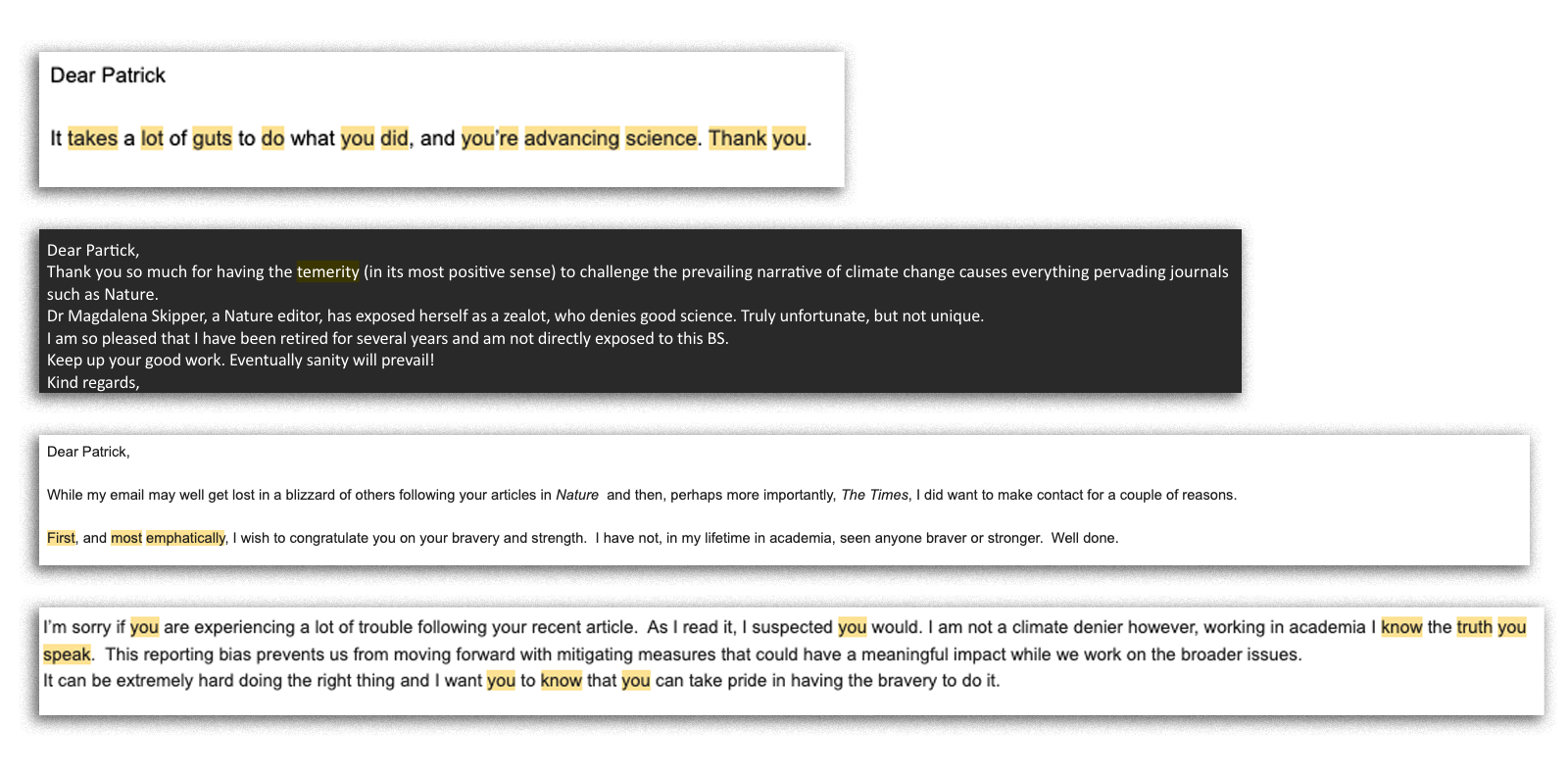
Any “hero” story starts with an origin story, and Brown’s begins in Minnetonka, Minnesota, on the outskirts of Minneapolis, where an average of 53 inches of snow falls per year, and tornado season typically lasts from May to September. As a weather-obsessed 10-year-old, Brown probably could have told you facts like those. By that point, in the mid-1990s, he had already written his first weather newsletter (recently unearthed at his mom’s house) explaining how warm and cold fronts cause unstable weather.
After going to the University of Wisconsin to pursue his dream of becoming a meteorologist, Brown found that the actual work of making weather maps for newspapers wasn’t what he wanted. “It was this terrible assembly line job, actually, where you had to draw like 20 different maps in a day, just going as fast as you could on Adobe Illustrator, eating lunch at your desk,” he said. So Brown headed to San Jose State University for his master’s degree to do climate research instead. He says his background in meteorology gives him a different point of view: Whereas those who come from an environmental science background may view humans ruining nature as the problem, meteorologists tend to see the weather as a threat to people’s safety.
When Brown started teaching classes as a master’s student, he was surprised to find the science on climate impacts in the textbooks was thinner than he’d expected. He was initially motivated to “beef that up,” to show his class how severe the weather changes were. But the more he looked into it, the more he found that what he had assumed were dramatic changes were “very small, very subtle, very uncertain.” He began seeing a disconnect between what the science showed and how it got communicated.

After finishing a Ph.D. at Duke, Brown joined Ken Caldeira’s lab at Stanford for his postdoctoral research, to examine how the climate system interacts with the world we’ve built. Caldeira, now an emeritus scientist with Carnegie Science, said that Brown was “one of the best and most productive postdocs that have ever been in my group during my entire career.” He described Brown as a bit of a lone wolf, someone who “tends to sit in front of his laptop and grind away at his work.” Brown published his first paper in Nature with Caldeira in 2017, showing that the most alarming climate models tended to be the most accurate.
Brown landed a tenure-track job as an assistant professor back at San Jose State in 2019, but he became uncomfortable with what he had come to see as the clearest path to success: mining data to show the negative effects of climate change. Wanting more freedom, Brown joined the Breakthrough Institute in 2022, a Bay Area think tank dubbed by the San Francisco Chronicle as “the most controversial climate nonprofit you’ve never heard of.”
It’s a safe place for people with unpopular ideas, known for advocating for nuclear power. “You don’t come to work at the Breakthrough Institute without an understanding that we exist to challenge what we believe to be stuck debates in environmentalism, in energy and climate policy, and beyond,” Trembath said.
Freed from the restrictions of academic publishing, Brown began writing opinionated pieces on the Breakthrough Institute’s site — critiques of how “science says” has been used as a “bludgeon” in policy debates on matters that science can’t really speak to, or how scientists tend to communicate climate change’s contribution to weather extremes like heat waves in the most dramatic way, even if it’s a little misleading.
Brown started pointing out what he saw as biases in the publication process, and it slowly dawned on him that he might be contributing to the problem. “I was criticizing these other papers,” he said. “And I felt like, in order to really make this point, what I need to do is stop being a hypocrite and just criticize my own paper.”
Brown didn’t particularly want to run the resulting piece in The Free Press, a media company founded by Bari Weiss, a journalist who resigned from The New York Times opinion desk in 2020 over the newspaper’s culture of alleged hostility toward staffers who held centrist or conservative views. It just happened to be the first place that took Brown’s essay, after The Atlantic turned it down.
“It wasn’t like we were targeting venues that would be more visible to the right,” Brown said. “I would prefer it to be in The New York Times. But yeah, I don’t think it was going to be published there.” He has some regrets about the headline of the piece. The “full truth” phrasing, he said, “really made it very salacious and a very, like, academic fraud or misconduct type of thing.”
As for his co-authors, Brown says, he didn’t give them much advance notice of his plans to critique the paper because he wanted them to have “plausible deniability” in case they were questioned about it. “I wasn’t expecting them to be dragged into a firestorm,” he said. That said, at least one of Brown’s co-authors did approve of his essay, calling him a “real scientist” and a “badass” in a private email.
Some climate scientists say there’s truth to Brown’s claim that journals are more likely to accept certain kinds of studies. “There’s a scientific equivalent of the ‘if it bleeds, it leads’ dynamic that affects a lot of the media,” said Zeke Hausfather, a climate scientist who previously worked at the Breakthrough Institute and first met Brown at Stanford. “Particularly in the top journals like Science and Nature, you are much, much more likely to have a shot at getting a paper in there — which, at least in the traditional academic sense, can be somewhat career-defining — if you have a dramatic finding, if you have a finding that ties into issues that are in the zeitgeist.”
Ken Caldeira said that a paper that supports the prior beliefs of a reviewer — such as one that shows bad things are going to happen because of climate change — is probably going to have an easier time getting through peer review than one that questions their beliefs.
In hindsight, Brown says he would have put less blame on journal editors specifically, and more emphasis on the overall culture of climate science, which affects what kind of papers get submitted in the first place. At the moment, he’s trying to publish another study about California’s wildfires, showing that a forest management technique called fuel reduction — removing the extra-flammable vegetation in forests — could completely offset the effects of climate change on wildfire danger in California.

Scientists have long been hesitant to focus on climate adaptation, worried that it would distract from the goal of keeping CO2 out of the atmosphere. Brown understands it’s necessary to reduce emissions in the long run, but he wants people to know that there are options for reducing the threats from fires, floods, and other climate-related disasters right now. “I think that there is an alternative world where all of these headlines in Science and Nature are about these successes and then studying why we’re good at that,” Brown said. “That would be an alternative world that I think could potentially make for much better outcomes for humans.”
Brown submitted his second wildfire study to Nature earlier this year, acknowledging last year’s incident in his submission only to be turned down. Other prestigious journals, including Science, The Proceedings of the National Academy of Sciences, and Science Advances, didn’t want it either, Brown said. Currently, the paper is in peer-review at Environmental Research Letters, which Brown describes as “not a high-impact journal but a decent outlet.”
He’s waiting to hear back.
The anti-hero
While the world has mostly moved on from the Nature incident, Brown hasn’t backed away from the stance that scientists need to tell a more complicated story about the impacts of climate change.
In front of a crowd of about 30 people at the conference I attended in June, Brown studied a pile of papers on his lap, rubbing his chin as he waited for his turn to talk. It was a panel on “climatism,” a term that Mike Hulme, a professor of human geography at the University of Cambridge, uses to refer to an ideology that tries to dump the world’s complex problems into the “climate change” bucket.
Brown points out facts that fit rather awkwardly in that bucket. For example, the Intergovernmental Panel on Climate Change, the world’s leading authority on climate science, has “low confidence” that floods are increasing on a global scale (even though some areas are flooding more). Hurricanes are not definitively getting more frequent or stronger (though they do tend to drop more rain than they used to). Sure, climate change has lowered crop yields, Brown notes, but technological advances have outweighed the impact of weird weather. Thanks to the advances in fertilization, irrigation, and pest control, crop yields have increased dramatically since the 1960s.

According to Brown, when experts ignore this real-world evidence, they unintentionally mislead the public. “It’s effectively lying to people,” he told the crowd at the Breakthrough Institute panel. “And we shouldn’t do that as a scientific community.”
The audience seemed receptive to Brown’s message, though it was admittedly a self-selected crowd that wanted to go to a panel about “climatism.” In the wider world, a member of the audience pointed out, taking an anti-doom stance makes you look like a bad person: There’s no popular story where the hero is the guy telling you not to worry about the approaching asteroid. “If this was a film,” he said, “everyone who’s spoken so far would be played by a B-list actor” who says, “Oh, it’s not that bad!”
There is, however, a well-known archetype that easily fits the Brown affair: the anti-hero. And compared to villain or hero tales, it’s a bit more complicated. By one definition, an anti-hero has the following characteristics: They are doomed to fail before the action begins, they refuse to accept blame for the failure, and they serve as a vehicle for a critique of society.
By this point, Brown’s critique should be clear, but was he doomed to fail?
Ted Nordhaus, the Breakthrough Institute’s founder and executive director, said there’s been “a narrowing down of what’s acceptable to talk about” in climate discussions. On one side, you have the valiant defenders of science, and on the other, the deniers pushing the world toward catastrophe. In these polarized conditions, a critique of climate science isn’t given real consideration — it’s quickly attacked by climate advocates and exaggerated by those who want to delay action. “I think that is ultimately at the bottom of a lot of this reaction, and a lot of the upset, when someone like Patrick comes out and goes, ‘Hey, this sacred thing that we’re all involved in producing isn’t quite as sacred, or pure, as we often insist that it is,’” Nordhaus said.
Brown, in other words, may have been doomed to fail, because he wanted to complicate a conversation among people who see the stakes as clear as life or death.
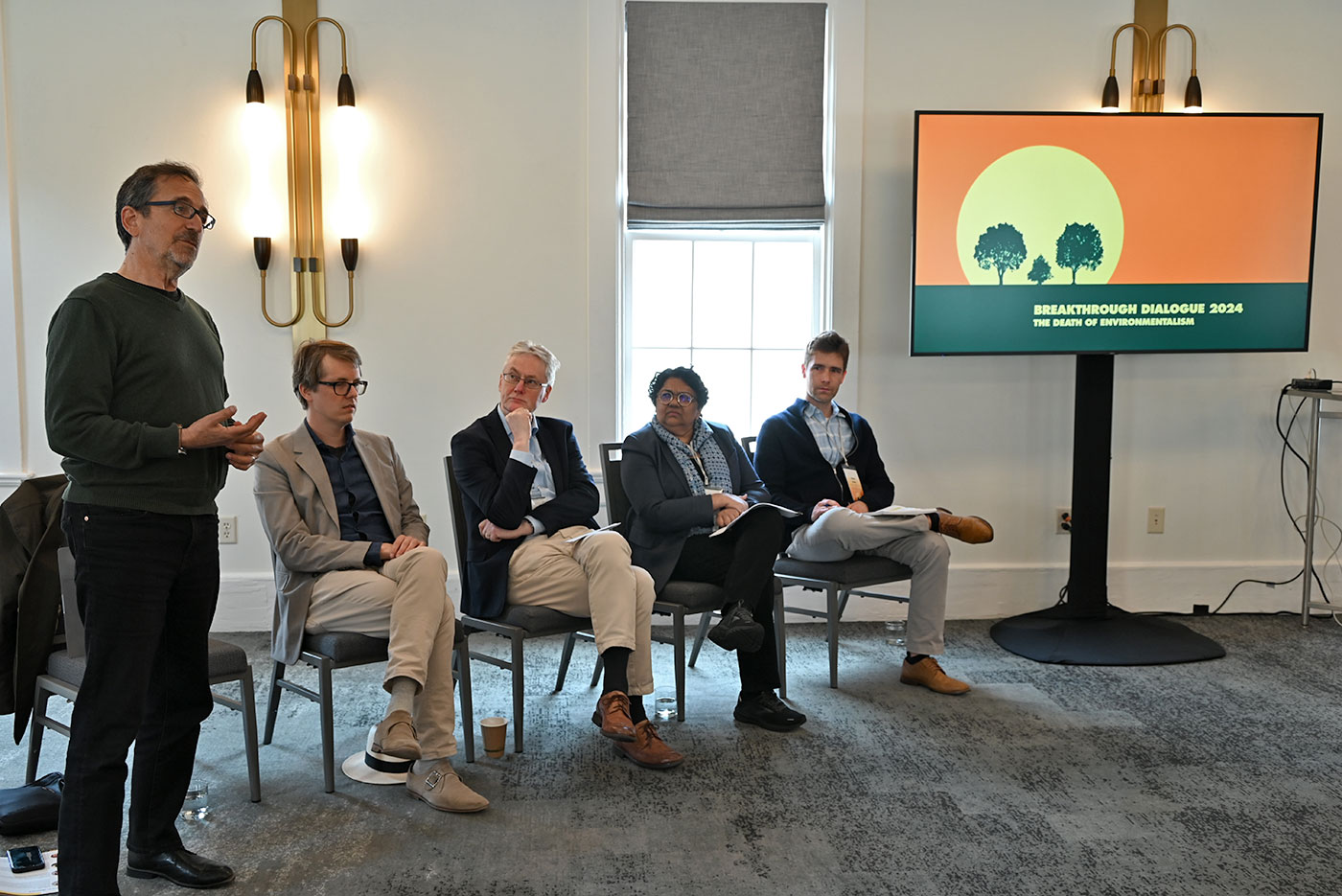
For his part, Brown refuses to accept blame for the fact that many people are unwilling to listen to his message. Caldeira, Brown’s postdoc advisor, says that using softer language might have been better for actually persuading people. “I think the kinds of things that Patrick’s trying to communicate are important and valuable,” Caldeira said. “But I think if they’re not communicated with great care, that there’s a tendency for people just to discount the source of communication and not look carefully at what’s being said.”
Brown takes the criticism but doesn’t plan to use more careful language, because he thinks readers should know he has a point of view. He knows his opinions aren’t popular; that’s part of why he left academia (though he still teaches some climate classes at Johns Hopkins University). “If you actually want to do research that’s kind of explicitly against the mainstream — like, if you want it to really highlight that crop yields are going up despite it being warmer — then you’re inviting a lot of potential trouble,” he said. “Socially, it’s kind of awkward. Like, you don’t really want to be in the faculty meeting, maybe, if that’s your reputation.” In fact, a recent study found that people who express nuanced views and take the middle road in polarized debates tend to be widely disliked.
Despite the backlash, Brown says he would do it all over again. He thinks that if scientists do their best to explain the world as it is, putting politics aside and exploring a wider range of questions, they’ll earn more public trust. “What I hope is that it can make maybe a subconscious impact on people,” he said, “that even if they lashed out against it, or wrote something critical about me about it at the time, that it germinated an idea, potentially, in their heads that the issue I’m talking about is real.”
As time has worn on, Brown says he has seen the hostility toward his ideas start to die down. He was recently invited, for instance, to give a talk on his wildfire research and his critique of climate science at Columbia University’s climate school.
After the “climatism” panel ended in June, I tracked down Brown for one last in-person conversation. As we sat side-by-side on Adirondack chairs looking over the foggy vista of the Golden Gate Bridge — it seemed easier that way, with neither of us having to make eye contact — I asked him some follow-up questions, and afterward, explained that my next step was to interview people who knew him. Then Brown said something I wasn’t expecting. Would I talk to his critics? He hoped I would, and helpfully name-dropped a couple of them. Then he assured me that he’d grown a thick skin, so it was just fine if I ended up writing an unflattering story.
It made sense in hindsight. Brown wanted the complicated truth, the full story in all its messiness — even in an article about him.

